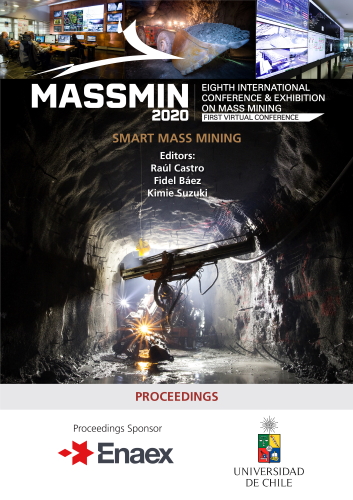Analysis of drillhole deviation during drawbell construction in block caving

|
Authors: Bustos, N; Villaescusa, E; Onederra, I |
This paper is hosted with the kind permission of Lulea University of Technology, International Conference & Exhibition on Mass Mining, 2024.
DOI https://doi.org/10.36487/ACG_repo/2063_63
Cite As:
Bustos, N, Villaescusa, E & Onederra, I 2020, 'Analysis of drillhole deviation during drawbell construction in block caving', in R Castro, F Báez & K Suzuki (eds), MassMin 2020: Proceedings of the Eighth International Conference & Exhibition on Mass Mining, University of Chile, Santiago, pp. 883-896, https://doi.org/10.36487/ACG_repo/2063_63
Abstract:
In Block Caving drawbells allow for flow of broken rock. The drawbell construction starts with a drawbell design, which is constrained by the extraction layout shape and development drives sizes. The resulting shape of the drawbell is highly influenced by drilling performance, particularly drillhole deviation. This paper presents the results of a comprehensive analysis of drillhole deviation data undertaken from more than 2,000 holes of 76 mm diameter, having an average length of 12 m and drilled in more than 500 ring positions. In terms of drawbell design, the analysis indicates that the holes less affected by drillhole deviation are those with plunge angle ranging between 65° to 90°. Those holes are located near the centre of the drawbell. The holes less inclined show more deviation. They correspond to those forming the edge of the drawbell shape. Therefore, these areas can be exposed to possible blast damage due to confined charges. The analysis also indicated that 59% of the measured points have a drillhole deviation percentage (DD%) greater than 2%, while 2% of the points present a DD% over 10%. An industry standard for drawbell drill deviation along drilled depth was developed as a tool to check the effectiveness of a blast design, in terms of drill patterns that are likely to appear due to drillhole deviation.
References:
Brown, ET 2007, 'Block caving geomechanics', Indooroopilly, Qld., Julius Kruttschnitt Mineral Research Centre, The University of Queensland.
Brzovic, A, Rogers, S, Webb, G, Hurtado, JP, Marin, N, Schachter P, Alvarez J & Barahona, K 2015. 'Discrete fracture network modelling to quantify rock mass pre-conditioning at the El Teniente Mine', Chile. Mining Technology, vol 124, pp. 163-177.
Brzovic, A, & Villaescusa, E 2007, 'Rock mass characterization and assessment of block-forming geological discontinuities during caving of primary copper ore at the El Teniente mine, Chile', International Journal of Rock Mechanics and Mining Sciences, vol 44, pp. 565-583.
Castro, R 2006, 'Study of the Mechanisms of Gravity Flow for Block Caving', Doctor of Philosophy, University of Queensland.
Davis, JC 1986, 'Statistics and data analysis in geology' (2nd ed.), New York: New York : Wiley.
Dershowitz WS & Herda HH, 'Interpretation of fracture spacing and intensity', In: J.R. Tillerson, WR, ed. Proceedings of the 33th U.S. Symposium on Rock Mechanics, 1992 A.A. Balkema, Rotterdam
Golden Software, L 2019, Surfer. Golden, Colorado.
Hamrim, H 1993 'Precision drilling extends the range of long hole blasting', In: Almgren, G, Kumar, U & Vagenas, N, eds. Second International Symposium on Mine Mechanization and Automation, 7–10 June 1993 Luleå, Sweden Rotterdam, the Netherlands. A.A. Balkema, pp. 143–151.
Heilig, J 1999, 'Blast engineering' - Course notes for the masters of engineering science in mining geomechanics. Kalgoorlie, Western Australia, Australia: Western Australian School of Mines, Curtin University.
Hekmatnejad, A, Emery, X, Brzovic, A, Schachter, P & Vallejos, JA 2017, 'Spatial modeling of discontinuity intensity from borehole observations at El Teniente mine, Chile', Engineering Geology, vol 228, pp. 97-106.
Heumann, C, Schomaker, M & Shalabh 2016, 'Introduction to Statistics and Data Analysis', Switzerland, Springer International Publishing AG.
Persson, PA, Holmberg, R & Lee, J 1994, 'Rock blasting and explosives engineering', Boca Raton, Florida, CRC Press.
Pierce, M 2010, 'A model for gravity flow of fragmented rock in block caving mines'. Doctor of Philosophy, University of Queensland.
REFLEX, T 2019, 'The End-to-end Solution for Downhole Navigation', Available from: <>/ [11-09-2019].
Rojas, E, Molina, R, Bonani, A & Constanzo, H 2000, 'The Pre-Undercut Caving Method at the El Teniente Mine, Codelco Chile', In: G, C. (ed.) Proceedings MassMin 2000, Brisbane: Australasian Institute of Mining and Metallurgy: Melbourne.
Rostami, J & Hambley, D 2011, '7.2 Blasthole Drilling'. In: DARLING, P. (ed.) SME Mining Engineering Handbook (3rd Edition), Society for Mining, Metallurgy, and Exploration (SME).
Velleman, P, Hoaglin, D & Harvard, U 2004, 'Applications, basics, and computing of exploratory data analysis', Ithaca, N.Y. , The Internet-First University Press.
Villaescusa, E 2014, 'Geotechnical Design for Sublevel Open Stoping', Taylor & Francis.
© Copyright 2025, Australian Centre for Geomechanics (ACG), The University of Western Australia. All rights reserved.
View copyright/legal information
Please direct any queries or error reports to repository-acg@uwa.edu.au
View copyright/legal information
Please direct any queries or error reports to repository-acg@uwa.edu.au
